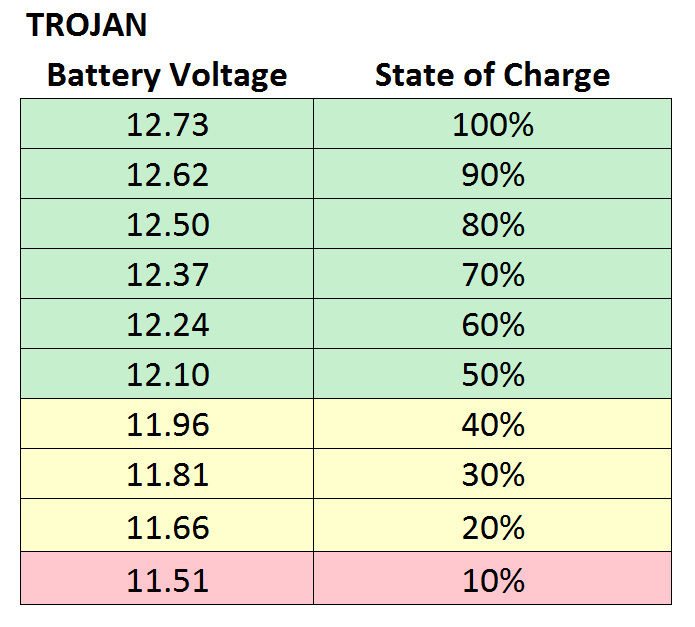This is an old revision of the document!
Table of Contents
Depth of discharge / State of Charge
 Depth-of-discharge (DoD or DOD) refers to how low a deep cycle battery is taken between full charges. DoD is the inverse of State of Charge (SoC). Example: a battery at 30% DoD is at 70% SoC.
Depth-of-discharge (DoD or DOD) refers to how low a deep cycle battery is taken between full charges. DoD is the inverse of State of Charge (SoC). Example: a battery at 30% DoD is at 70% SoC.
For solar powered systems the greatest DoD (and therefore lowest SoC) will be in early morning just before the panels start creating power again.
DoD has a significant impact on longevity of deep cycle batteries. For this reason Inverters and other high-load devices may have a low voltage cutoff.
effect of SoC on battery life
How deeply one discharges lead-chemistry batteries will have a direct effect on how long the battery bank will last.1)
The most common discharge limit for deep cycle batteries is 50% DoD. This gives a good balance between usability and longevity. The lowest cost per Ah occurs around 30% DoD although this requires buying, installing, and moving dead lead or unusable battery capacity.2)
Based on the following data on the Trojan T-105:
- lowest cost per Ah happens at 30% DoD
- longest life happens at 20% DoD
- least battery weight happens at 80% DoD
so make your DoD decision based on what is most important to you.
| T105 Ah | Cost | weight per set | Target Ah | |||||
| 225 | $260.00 | 124 | 175 | |||||
| DoD | State of Charge | power per cycle | Num. of cycles | lifetime power in Kah3) | levelled cost / Kah | life in years | Sets needed for target Ah | Weight |
| 10 | 90 | 22.5 | ||||||
| 20 | 80 | 45 | 3000 | 135 | $1.93 | 8.2 | 3.9 | 482 |
| 30 | 70 | 67.5 | 2250 | 151.875 | $1.71 | 6.2 | 2.6 | 321 |
| 40 | 60 | 90 | 1450 | 130.5 | $1.99 | 4.0 | 1.9 | 241 |
| 50 | 50 | 112.5 | 1200 | 135 | $1.93 | 3.3 | 1.6 | 193 |
| 60 | 40 | 135 | 1050 | 141.75 | $1.83 | 2.9 | 1.3 | 161 |
| 70 | 30 | 157.5 | 900 | 141.75 | $1.83 | 2.5 | 1.1 | 138 |
| 80 | 20 | 180 | 800 | 144 | $1.81 | 2.2 | 1.0 | 121 |
One can choose to run the batteries quite hard in emergency or temporary conditions with the understanding that it will likely “hurt” the batteries to some degree. Consistently going past 50% DoD will greatly reduce the battery's usable cycles. Some studies suggest discharging to 80% yields 1/10th the number of cycles available at 20%.
SoC by amps
A battery monitor, usually a amp/coulumb counter with a shunt, will measure the current going to/from the battery. It will often show real-time current flow and a state of charge percentage. It may also show voltage (see below).
SoC by voltage
100% SoC (~12.7v) is measured after the bank has been fully charged and then rested. It is measured “on the way down”; measuring “on the way up” while charging will lead to false confidence and leaving the battery less than fully charged.
The voltage level associated with 50% DoD is widely discussed. 12.1v rested is generally used as 50% State of Charge (SoC). A more conservative approach uses 12.2vdc rested.
Since resting is rare in most practical scenarios stopping at 12.2vdc under light loads would be a practical approach. DC expert SternWake4) says: “…those who are loading their battery and stop at 12.2v are treating their battery better, just not using all the capacity they could and perhaps seriously inconveniencing themselves by thinking they need to stop at this point, especially if the loads are fairly large, like while running a laptop and watching tv and while their fridge compressor is running.”5)
By this yardstick both of these uses should keep DoD from going beyond 50%:
- constant light loads with measured >=12.2v
- intermittent heavier loads that leave the system with measured >=12.2v when that load is removed
SoC by specific gravity
“The truest measure of a battery's state of charge is the specific gravity of the battery acid.” – Rolls battery.6)
Only flooded-type batteries are practical SoC assessment by SG of the electrolyte. Needed for this operation:
- temperature of the battery
- SG chart from the battery manufacuturer
partial state of charge
This section has moved.

